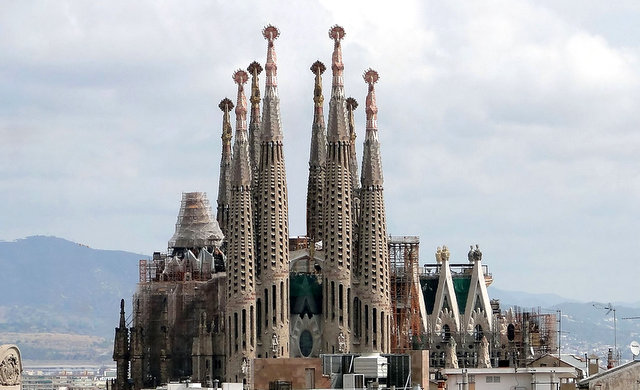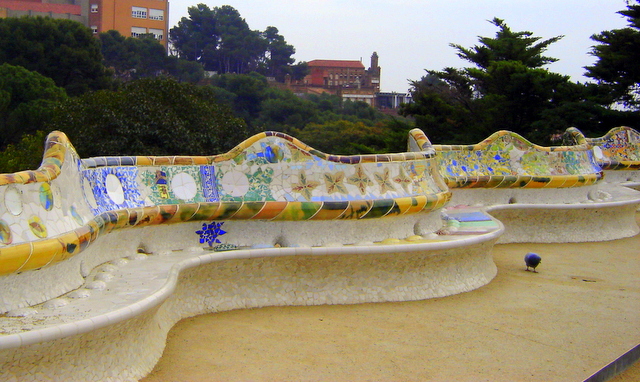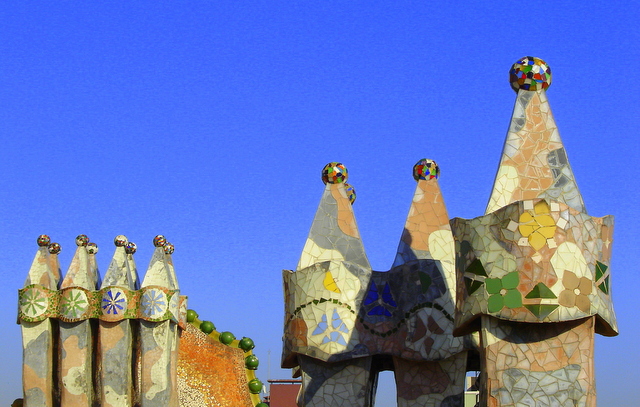There can be few cities and architects in the world whose names are more closely linked than those of Barcelona and Antoni Gaudi. Born in 1852 (died 1926) he became a leading figure in the Catalan Modernist movement of the late 19th and early 20th centuries, but inspired by the forms he found in nature he developed a style of architecture and decoration that transcended labels and is nowadays seen as truly unique.
For the visitor to Barcelona there are four Gaudi creations that are absolute must-sees.
 photo courtesy of wikimedia
photo courtesy of wikimedia
Sagrada Familia
The Sagrada Familia, or Basilica and Church of the Holy Family (it’s not a cathedral – Barcelona already has one of those), is considered to be Gaudi’s masterwork. He took control of the project in 1883, shortly after it began, and as of today, more than 130 years later, it is still under construction, though there is a target for completion of 2026 to mark the centenary of his death.
Both the scale and the intricacy of the work are amazing. The eight (so far) tapering towers rise out of a fairly mundane suburban backdrop, and the church’s three facades, representing the Nativity, the Passion and the Glory, are adorned with scenes from the life of Christ. As with all Gaudi’s work, it’s the attention to detail that fascinates, especially the more whimsical elements, like the tortoises that form the bases of some of the pillars.
Be prepared for long queues, which in the summer heat call for considerable fortitude and plenty of water!
 tiled benches in Parc Güell
tiled benches in Parc Güell
Park Güell
Quite different is Park Güell, originally conceived as a housing project, but now a municipal garden on a hill overlooking the north of the city. Here you can find some of Gaudi’s best known work, including the mosaic salamander, and the entrance pavilions that always remind me irresistibly of gingerbread houses, The hypostyle hall, with the terrace of curved benches that forms its roof, has an Egyptian inspiration, and like many of the architectural elements seems almost to have grown out of the ground.
Entrance to the park was free until last year – now there is an 8€ charge.
Casa Mila (La Pedrera)
Down on the Passeig de Gracia (Barcelona’s main shopping street) you can find the first of the two most famous Gaudi houses, designed and built by Gaudi for a wealthy Catalan businessman, the Mila House. It’s most obviously notable for being built almost entirely of curves with very few straight lines or surfaces. My favourite things here are actually the “witch-scarers” on the roof, which bear a striking resemblance to Star Wars stormtroopers, but the whole building is worth exploring at length.
 “dragon’s back” rooftop of Casa Batlló
“dragon’s back” rooftop of Casa Batlló
Casa Batlló
My favourite Gaudi of all, however, can be found a little further down the street. Casa Batlló, like the Mila totally renovated for a wealthy businessman, is also known locally as the “House of Bones”, and it’s easy to see why. The balconies of the façade closely resemble skulls, and the window supports of the main floor do look remarkably like bones. From inside, the effect of the curved windows is really stunning, but as at Mila, everything seems to be curved, and gives a slightly eerie feeling of being inside something living. Make sure to see the interior light-well, the atrium, with its bright tiles extending dizzyingly right up through the full height of the building.
Veoapartment has recently acquired several new additions to our holiday rental properties, many of them in the stylish Eixample and boho Gracia neighbourhoods, close to these fabulous Gaudi buildings and other important sights.